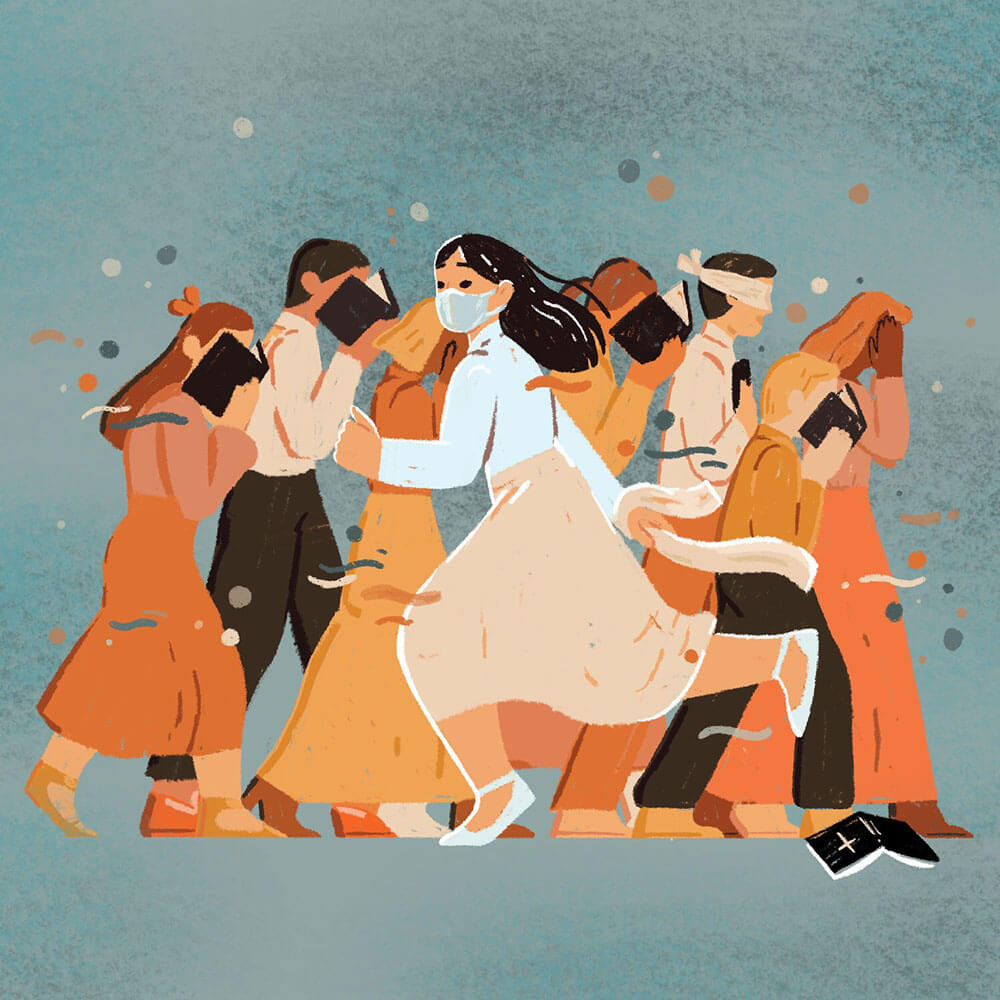
I have known a white Jesus my entire life. My parents had first heard of him when they immigrated to the U.S. from Taiwan to attend graduate school in North Carolina, where assimilation was a means of survival. We had kept an illustration of him in the company of children atop the upright piano in our living room. I used to stare at him, in awe of his wavy brown hair and full beard, and the doe-eyed children, all blond-haired boys. This was the Jesus I prayed to when I recited the prayer of salvation in Sunday school, the Jesus I envisioned singing praises to in heaven — represented by the gold bead of my faith bracelet. During worship nights at church retreats, I would belt “the cross before me, the world behind me, no turning back, no turning back”, yearning to die to myself and become washed white as snow.
Since the beginning, my relationship with this white Jesus was complicated. I knew he loved me, but his love came with costs. I needed to pray to him regularly so that he would rescue me from myself, because white Jesus taught me that, apart from Christ, no good thing lived in me. The process of redemption involved stripping away everything about me that was unique and becoming a vessel to do his work 24/7. But I also loved this white Jesus because he first loved me, way back when he was with white God. This was before the white God sacrificed his only son for a sinful creature like me so that I wouldn’t need to suffer in hell. I could trust this white God. While he could smite me at any moment, he chose not to, thanks to the unwavering faith of the founding fathers who occupied this land.
I took it as an act of sacrifice to work for this white God. When I was in middle school, out of devotion to him, I told one of my friends that she was going to hell for being gay. I ended other friendships with people I liked because they were unbelievers. “Hate the sin, love the sinner” was the form of tough love that I practiced to bear witness to my life in Christ. I went on mission trips abroad and to the “inner city” with nothing but a zeal to save their souls, giving up summers to sing worship songs with people I would never care to see again. This all made sense though, because white God was about self-denial. Too much consideration of my needs would prevent me from pursuing my calling as a living sacrifice. Too much attachment to the world and I would lose my devotion to Christ. Too much socializing with unbelievers and I would stumble. Happiness was overrated anyway — it was true joy that I was after. And true joy came from knowing that my salvation was secure, my works the fruit of faith.

Through white God’s teachings, I learned about the supremacy of certain interpretations of the Bible over others, and through these interpretations I became good at quietly accepting contradictions. While I knew that women were created in the image of God, I learned that men were the superior creation. I learned how to embrace the queer community so long as they acted straight and had no voice in the church. I learned that loving my neighbor was important so long as they weren’t children or families risking their lives to escape violence in Central America, violence resulting from the days when the U.S. helped overthrow their governments. I learned that zygotes, embryos, and fetuses were valued citizens, while those who benefit from public assistance to raise their children are not. I learned that any initiatives for supporting trafficking victims were worthy causes so long as the victims resemble white Jesus and not like the undocumented folks who sustain the economy. In 2020, I learned how white God agrees that “Black lives matter”, but only because all lives matter — particularly “blue” lives.
White God showed me that as his follower, I was among the most oppressed group in the world and should expect to be persecuted throughout life. In middle school, I had nightmares of being killed for rejecting the mark of the beast during the end times. In high school, persecution meant being shunned for raising my hand in Earth Science class and asking how an infinite universe could emerge without an infinite creator. In 2020, persecution for white God has looked like being banned from gathering in the Lord’s House on Sundays because of a virus that Democrats and scientists allegedly blew out of proportion.
In the beginning, there was white God and white God created a world of opposites — dark and light, evil and good, secular and Christian, sin and salvation, black and white.
To white God, there is believer and unbeliever — believers are strictly followers of white God. They are deemed good and deserve religious freedoms, while unbelievers who are not followers of white God, such as Muslims or those who pray to their ancestors or spirits, deserve conversion or death. In white God, there is man and not-man — man we know to be good, and not-man — like woman, queer folx, and the entirety of BIPOC communities were designated as less good.
White God always knows what is best for everyone. With utmost clarity, white God discerned that Africans were descendants of Ham and that enslaving them was a fine way to pay for their sins. White God also knew it was better for the indigenous communities of the Americas to be massacred lest they prevent faithful colonists from claiming rights to the land. White God knows a thing or two about building kingdoms, such as how preaching the white gospel to the ends of the earth often necessitated using converts for labor and their land for resources.
My relationship with white Jesus spanned 32 years until 2020, when I finally saw that my proximity to him was really a proximity to white supremacy — in particular, white supremacy that was centered in the holy trinity of imperialism, capitalism, and patriarchy.
In the last four years, I have witnessed the ways in which the Trump administration has used fear to mobilize swaths of white Jesus-loving churches. Through his addresses and partnership with right-wing media outlets, he has reframed the narrative of the United States as one in which straight, white, church-going, flag-loving, American families are under attack by ANTIFA and the heinous socialist liberal elite. In fact, he has been riding this wave of white evangelical support since his campaign beginnings in 2016. In a campaign speech Trump gave at a Christian college in Sioux Center, Iowa, he promised that under his leadership, Christianity would have power again. In the following November, exit polling revealed that 81% of white evangelicals cast a vote for him. Since his inauguration, Trump went on to pass policies that drew from white evangelicals’ worst fears related to terrorism, the economy, immigration, race, and the dissolution of the “traditional” family. Out of those fears came discriminatory policies that banned travel on the basis of religion, severely limit refugee admissions starting, imprisoned asylum seekers, and handed over accompanying children to “shelters” across the country. All the while, white evangelicals stayed silent out of a desire to not appear aligned with the very secular forces that they feared were laying siege to Christian identity in the U.S.
This unabashed embrace of xenophobia was displayed again in 2019 when a “proud God-loving Christian” acted upon Trump’s anti-immigrant rhetoric and open fired at a shopping center in El Paso, Texas targeting the Latinx community there. Then in 2020 during his re-election campaign at Dream City Church in Phoenix, Trump referred to COVID-19 as the Kung Flu to a congregation that responded in praise. Following both instances, conservative evangelical leaders remained steadfast in their support of Trump, choosing to keep their place of power in politics.
In 2020, the facade of the white evangelical church’s moral authority completely unraveled in light of the Black Lives Matter protests. While communities banded together to demand justice for Ahmaud Arbery, Breonna Taylor, George Floyd, Elijah McClain, Rayshard Brooks, and Jacob Blake, a number of white evangelicals and white evangelical-aligning institutions released statements on the importance of unity. These statements appear to display Christ’s love for our neighbor, but silence the voices of those who are hurting the most. Rather than joining in collaboration to protest a criminal justice system that has long doled out free passes to police officers for shooting Black folks, white evangelicals spoke on racial reconciliation and drowned out a community mourning George Floyd at his memorial in Minneapolis with Bethel music. Rather than act in solidarity with victims of police violence, a Christian crowdfunding website announced raising $97 million to support legal fees for the 17-year-old gunman who killed two individuals at a Black Lives Matter protest. Rather than support the work that is being championed by the communities of color who are most affected by police brutality, coalitions of Christian groups launched the “Prayer and Action Justice Initiative”, seeking to rally Christians to advance racial justice through unity in biblical principles.
Despite playing a significant role in shaping American history, culture, and values in such a way that establishes and pardons a system that strips communities of color of their power, white evangelical networks continue vying to assert their white Jesus moral leadership over others.
So much of my life has revolved around the evangelical church, but this year my disillusionment with the faith I grew up with led me to leave. No amount of mental gymnastics could bridge the dissonance that came from listening to Sunday sermons and worship about God’s love while entire communities continue bearing the unequal burden of injustice. The events that have unfolded in 2020 have helped me see how the the Christianity I was socialized in, the one that glorifies the theological interpretations of a few white men, has been used as an industry to erase BIPOC struggles, voices, histories, and cultures. 2020 has also been a hard year for my partner and I, who have entered a season of grief that has stretched us to new breaking points. The Christianity that offers cute platitudes and the promise of white Jesus in the face of crushing tension and chaos is not for me.
I represent a large segment of folks from East Asian immigrant communities in the United States who were grafted into evangelical Christianity. Despite attending churches that were predominantly Asian or Asian American, these spaces were modeled after dominant American Christianity values — values that promote turning a blind eye to injustice caused and perpetuated by the faith. The benefits of staying with white Jesus were substantial — I cherish both my theological security in being set apart and my relational security in being surrounded by people who I love as family. But the cost of staying with white Jesus involves affirming a theology that imbues white and white-aligning communities while marginalizing, disenfranchising, separating, terrorizing, erasing, and murdering BIPOC communities in varying ways.
I feel more isolated than ever, but I am grateful for friends who walk with me along another path. I’m grateful to Brandi Miller who hosts the "Reclaiming My Theology" podcast and highlights voices that have helped me find my way out of cynicism. I am inspired by Erna Kim-Hackett, who founded Liberated Together, and the cohort I was a part of who helped me make sense of my disillusionment and gave me hope in another Jesus.
Currently, I’m searching for this other Jesus — the brown-skinned Middle Eastern Jesus who was born in the margins, lived in the margins and died in the margins. I’m searching for the Jesus who entered this world in the barn of a rural village. The Jesus who was born out of wedlock to an uneducated teenage girl of unremarkable social standing and raised by his adoptive father. The Jesus who never accumulated wealth, never owned a home, never pastored at a church, never married, and who worked a blue-collar job his whole life.
I want to know the Jesus whose death exemplified a life lived in opposition to systems that prescribed authority to certain groups over others. The Jesus who upset the religious elite by who he sought to befriend. The Jesus who found solidarity with those who were denied power in his time — women, children, anarchists, laborers, foreigners, outsiders — and centered their narratives.
In 2020, I’m looking for another Jesus.

Kimberlie Clinthorne-Wong is an illustrator and ceramic designer based in Hawaii. She is the cofounder of the collaborative ceramics studio, Two Hold Studios, LLC. Kimberlie’s work can be found at www.kimberliewong.com and on Instagram @kimiewng.
